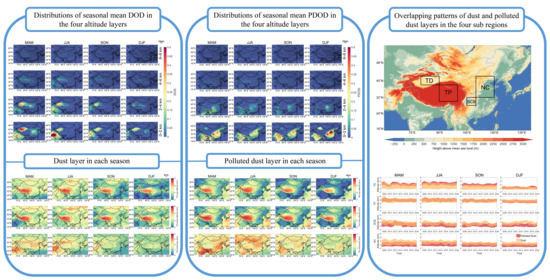Three-Dimensional Distribution and Transport Features of Dust and Polluted Dust over China and Surrounding Areas from CALIPSO
Abstract
:1. Introduction
2. Materials and Methods
2.1. CALIOP Level 3 Aerosol Product
2.2. ERA-5 Reanalysis
3. Results
3.1. Optical Depths of Dust and Polluted Dust
3.2. Transport and Mean Profiles of Dust and Polluted Dust
3.3. The Correlations between Meteorological Factors and DOD/PDOD
3.4. Variations of Dust and Polluted Dust Layers
4. Conclusions
Author Contributions
Funding
Data Availability Statement
Acknowledgments
Conflicts of Interest
References
- Ramanathan, V.; Crutzen, P.J.; Kiehl, J.T.; Rosenfeld, D. Aerosols, Climate, and the Hydrological Cycle. Science 2001, 294, 2119–2124. [Google Scholar] [CrossRef] [PubMed]
- Wang, Y.; Li, J.; Zhao, Y.; Li, Y.; Zhao, Y.; Wu, X. Distinct Diurnal Cycle of Supercooled Water Cloud Fraction Dominated by Dust Extinction Coefficient. Geophys. Res. Lett. 2022, 49, e2021GL097006. [Google Scholar] [CrossRef]
- Ramachandran, S.; Ghosh, S.; Verma, A.; Panigrahi, P.K. Multiscale Periodicities in Aerosol Optical Depth over India. Environ. Res. Lett. 2013, 8, 014034. [Google Scholar] [CrossRef]
- Higurashi, A.; Nakajima, T. Detection of Aerosol Types over the East China Sea near Japan from Four-Channel Satellite Data. Geophys. Res. Lett. 2002, 29, 17. [Google Scholar] [CrossRef]
- Omar, A.H. Development of Global Aerosol Models Using Cluster Analysis of Aerosol Robotic Network (AERONET) Measurements. J. Geophys. Res. 2005, 110, D10S14. [Google Scholar] [CrossRef]
- Singh, A.; Anchule, A.; Banerjee, T.; Aditi, K.; Mhawish, A. Three-Dimensional Nature of Summertime Aerosols over South Asia. Sci. Total Environ. 2022, 842, 156834. [Google Scholar] [CrossRef]
- Burton, S.P.; Ferrare, R.A.; Hostetler, C.A.; Hair, J.W.; Rogers, R.R.; Obland, M.D.; Butler, C.F.; Cook, A.L.; Harper, D.B.; Froyd, K.D. Aerosol Classification Using Airborne High Spectral Resolution Lidar Measurements—Methodology and Examples. Atmos. Meas. Tech. 2012, 5, 73–98. [Google Scholar] [CrossRef]
- Guo, J.; Lou, M.; Miao, Y.; Wang, Y.; Zeng, Z.; Liu, H.; He, J.; Xu, H.; Wang, F.; Min, M.; et al. Trans-Pacific Transport of Dust Aerosols from East Asia: Insights Gained from Multiple Observations and Modeling. Environ. Pollut. 2017, 230, 1030–1039. [Google Scholar] [CrossRef]
- Hu, Q.; Wang, H.; Goloub, P.; Li, Z.; Veselovskii, I.; Podvin, T.; Li, K.; Korenskiy, M. The Characterization of Taklamakan Dust Properties Using a Multiwavelength Raman Polarization Lidar in Kashi, China. Atmos. Chem. Phys. 2020, 20, 13817–13834. [Google Scholar] [CrossRef]
- Hofer, J.; Althausen, D.; Abdullaev, S.F.; Makhmudov, A.N.; Nazarov, B.I.; Schettler, G.; Engelmann, R.; Baars, H.; Fomba, K.W.; Müller, K.; et al. Long-Term Profiling of Mineral Dust and Pollution Aerosol with Multiwavelength Polarization Raman Lidar at the Central Asian Site of Dushanbe, Tajikistan: Case Studies. Atmos. Chem. Phys. 2017, 17, 14559–14577. [Google Scholar] [CrossRef]
- Hofer, J.; Ansmann, A.; Althausen, D.; Engelmann, R.; Baars, H.; Abdullaev, S.F.; Makhmudov, A.N. Long-Term Profiling of Aerosol Light Extinction, Particle Mass, Cloud Condensation Nuclei, and Ice-Nucleating Particle Concentration over Dushanbe, Tajikistan, in Central Asia. Atmos. Chem. Phys. 2020, 20, 4695–4711. [Google Scholar] [CrossRef]
- Han, Y.; Wang, T.; Tang, J.; Wang, C.; Jian, B.; Huang, Z.; Huang, J. New Insights into the Asian Dust Cycle Derived from CALIPSO Lidar Measurements. Remote Sens. Environ. 2022, 272, 112906. [Google Scholar] [CrossRef]
- Wang, T.; Tang, J.; Sun, M.; Liu, X.; Huang, Y.; Huang, J.; Han, Y.; Cheng, Y.; Huang, Z.; Li, J. Identifying a Transport Mechanism of Dust Aerosols over South Asia to the Tibetan Plateau: A Case Study. Sci. Total Environ. 2021, 758, 143714. [Google Scholar] [CrossRef] [PubMed]
- Xiong, Z.; Xu, X.; Yang, Y.; Luo, T. Diurnal Vertical Distribution and Transport of Dust Aerosol over and around Tibetan Plateau from Lidar on International Space Station. Atmos. Res. 2023, 294, 106939. [Google Scholar] [CrossRef]
- Zhao, Z.; Cao, J.; Shen, Z.; Xu, B.; Zhu, C.; Chen, L.-W.A.; Su, X.; Liu, S.; Han, Y.; Wang, G.; et al. Aerosol Particles at a High-Altitude Site on the Southeast Tibetan Plateau, China. J. Geophys. Res. Atmos. 2013, 118, 11360–11375. [Google Scholar] [CrossRef]
- Zhang, X.Y.; Arimoto, R.; An, Z.S. Dust Emission from Chinese Desert Sources Linked to Variations in Atmospheric Circulation. J. Geophys. Res. 1997, 102, 28041–28047. [Google Scholar] [CrossRef]
- Laurent, B.; Marticorena, B.; Bergametti, G.; Mei, F. Modeling Mineral Dust Emissions from Chinese and Mongolian Deserts. Glob. Planet. Chang. 2006, 52, 121–141. [Google Scholar] [CrossRef]
- Chen, S.-P.; Lu, C.-H.; McQueen, J.; Lee, P. Application of Satellite Observations in Conjunction with Aerosol Reanalysis to Characterize Long-Range Transport of African and Asian Dust on Air Quality in the Contiguous U.S. Atmos. Environ. 2018, 187, 174–195. [Google Scholar] [CrossRef]
- Xu, C.; Ma, Y.M.; You, C.; Zhu, Z.K. The Regional Distribution Characteristics of Aerosol Optical Depth over the Tibetan Plateau. Atmos. Chem. Phys. 2015, 15, 12065–12078. [Google Scholar] [CrossRef]
- Liang, L.; Han, Z.; Li, J.; Xia, X.; Sun, Y.; Liao, H.; Liu, R.; Liang, M.; Gao, Y.; Zhang, R. Emission, Transport, Deposition, Chemical and Radiative Impacts of Mineral Dust during Severe Dust Storm Periods in March 2021 over East Asia. Sci. Total Environ. 2022, 852, 158459. [Google Scholar] [CrossRef]
- Sun, H.; Pan, Z.; Liu, X. Numerical Simulation of Spatial-temporal Distribution of Dust Aerosol and Its Direct Radiative Effects on East Asian Climate. J. Geophys. Res. 2012, 117, D13. [Google Scholar] [CrossRef]
- Perlwitz, J.; Tegen, I.; Miller, R.L. Interactive Soil Dust Aerosol Model in the GISS GCM: 1. Sensitivity of the Soil Dust Cycle to Radiative Properties of Soil Dust Aerosols. J. Geophys. Res. 2001, 106, 18167–18192. [Google Scholar] [CrossRef]
- Ahn, H.-J.; Park, S.-U.; Chang, L.-S. Effect of Direct Radiative Forcing of Asian Dust on the Meteorological Fields in East Asia during an Asian Dust Event Period. J. Appl. Meteorol. Climatol. 2007, 46, 1655–1681. [Google Scholar] [CrossRef]
- Ma, M.; Yang, X.; He, Q.; Zhou, C.; Mamtimin, A.; Huo, W.; Yang, F. Characteristics of Dust Devil and Its Dust Emission in Northern Margin of the Taklimakan Desert. Aeolian Res. 2020, 44, 100579. [Google Scholar] [CrossRef]
- Kai, K.; Tsunematsu, N.; Matsumoto, T.; Zhou, H.; Hu, S.; Nagai, T.; Matsumura, T.; Abo, M. Vertical Structure of the Dust Layer and Middle-Level Clouds over the Taklamakan Desert by LIDAR. In Proceedings of the 22nd Internation Laser Radar Conference (ILRC 2004), Matera, Italy, 12–16 July 2004; Volume 561, p. 895. [Google Scholar]
- Huang, J.; Minnis, P.; Chen, B.; Huang, Z.; Liu, Z.; Zhao, Q.; Yi, Y.; Ayers, J.K. Long-Range Transport and Vertical Structure of Asian Dust from CALIPSO and Surface Measurements during PACDEX. J. Geophys. Res. 2008, 113, D23212. [Google Scholar] [CrossRef]
- Iwasaka, Y.; Minoura, H.; Nagaya, K. The Transport and Spacial Scale of Asian Dust-Storm Clouds: A Case Study of the Dust-Storm Event of April 1979. Tellus B 1983, 35, 189–196. [Google Scholar] [CrossRef]
- Zhang, T.; Zheng, M.; Sun, X.; Chen, H.; Wang, Y.; Fan, X.; Pan, Y.; Quan, J.; Liu, J.; Wang, Y.; et al. Environmental Impacts of Three Asian Dust Events in the Northern China and the Northwestern Pacific in Spring 2021. Sci. Total Environ. 2023, 859, 160230. [Google Scholar] [CrossRef]
- Nee, J.B.; Chiang, C.; Hu, H.; Hu, S.; Yu, J. Lidar Measurements of Asian Dust Storms and Dust Cloud Interactions. J. Geophys. Res. 2007, 112, 2007JD008476. [Google Scholar] [CrossRef]
- Han, Y.; Wu, Y.; Wang, T.; Xie, C.; Zhao, K.; Zhuang, B.; Li, S. Characterizing a Persistent Asian Dust Transport Event: Optical Properties and Impact on Air Quality through the Ground-Based and Satellite Measurements over Nanjing, China. Atmos. Environ. 2015, 115, 304–316. [Google Scholar] [CrossRef]
- He, Y.; Yi, F.; Yin, Z.; Liu, F.; Yi, Y.; Zhou, J. Mega Asian Dust Event over China on 27–31 March 2021 Observed with Space-Borne Instruments and Ground-Based Polarization Lidar. Atmos. Environ. 2022, 285, 119238. [Google Scholar] [CrossRef]
- Sassen, K. Indirect Climate Forcing over the Western US from Asian Dust Storms. Geophys. Res. Lett. 2002, 29, 103–1-103–104. [Google Scholar] [CrossRef]
- Uno, I.; Eguchi, K.; Yumimoto, K.; Takemura, T.; Shimizu, A.; Uematsu, M.; Liu, Z.; Wang, Z.; Hara, Y.; Sugimoto, N. Asian Dust Transported One Full Circuit around the Globe. Nat. Geosci 2009, 2, 557–560. [Google Scholar] [CrossRef]
- Winker, D.M.; Pelon, J.; Coakley, J.A., Jr.; Ackerman, S.A.; Charlson, R.J.; Colarco, P.R.; Flamant, P.; Fu, Q.; Hoff, R.M.; Kittaka, C.; et al. The CALIPSO Mission: A Global 3D View of Aerosols and Clouds. Bull. Am. Meteorol. Soc. 2010, 91, 1211–1230. [Google Scholar] [CrossRef]
- Winker, D.M.; Hunt, W.H.; Hostetler, C.A. Status and Performance of the CALIOP Lidar. In Proceedings of the Laser Radar Techniques for Atmospheric Sensing, Maspalomas, Canary Islands, Spain, 4 September 2004; Volume 5575, pp. 8–15. [Google Scholar]
- Huang, J.; Wang, T.; Wang, W.; Li, Z.; Yan, H. Climate Effects of Dust Aerosols over East Asian Arid and Semiarid Regions. J. Geophys. Res. Atmos. 2014, 119, 11398–11416. [Google Scholar] [CrossRef]
- Yang, Y.; Zhao, C.; Wang, Q.; Cong, Z.; Yang, X.; Fan, H. Aerosol Characteristics at the Three Poles of the Earth as Characterized by Cloud–Aerosol Lidar and Infrared Pathfinder Satellite Observations. Atmos. Chem. Phys. 2021, 21, 4849–4868. [Google Scholar] [CrossRef]
- Huang, K.; Zhuang, G.; Li, J.; Wang, Q.; Sun, Y.; Lin, Y.; Fu, J.S. Mixing of Asian Dust with Pollution Aerosol and the Transformation of Aerosol Components during the Dust Storm over China in Spring 2007. J. Geophys. Res. 2010, 115, D7. [Google Scholar] [CrossRef]
- Huang, L.; Jiang, J.H.; Tackett, J.L.; Su, H.; Fu, R. Seasonal and Diurnal Variations of Aerosol Extinction Profile and Type Distribution from CALIPSO 5-year Observations. J. Geophys. Res. Atmos. 2013, 118, 4572–4596. [Google Scholar] [CrossRef]
- Tackett, J.L.; Winker, D.M.; Getzewich, B.J.; Vaughan, M.A.; Young, S.A.; Kar, J. CALIPSO Lidar Level 3 Aerosol Profile Product: Version 3 Algorithm Design. Atmos. Meas. Tech. 2018, 11, 4129–4152. [Google Scholar] [CrossRef] [PubMed]
- Winker, D.M.; Tackett, J.L.; Getzewich, B.J.; Liu, Z.; Vaughan, M.A.; Rogers, R.R. The Global 3-D Distribution of Tropospheric Aerosols as Characterized by CALIOP. Atmos. Chem. Phys. 2013, 13, 3345–3361. [Google Scholar] [CrossRef]
- Pan, H.; Huang, J.; Kumar, K.R.; An, L.; Zhang, J. The CALIPSO Retrieved Spatiotemporal and Vertical Distributions of AOD and Extinction Coefficient for Different Aerosol Types during 2007–2019: A Recent Perspective over Global and Regional Scales. Atmos. Environ. 2022, 274, 118986. [Google Scholar] [CrossRef]
- Ouyang, W.; Guo, B.; Cai, G.; Li, Q.; Han, S.; Liu, B.; Liu, X. The Washing Effect of Precipitation on Particulate Matter and the Pollution Dynamics of Rainwater in Downtown Beijing. Sci. Total Environ. 2015, 505, 306–314. [Google Scholar] [CrossRef]
- Sen, A.; Abdelmaksoud, A.S.; Nazeer Ahammed, Y.; Alghamdi, M.A.; Banerjee, T.; Bhat, M.A.; Chatterjee, A.; Choudhuri, A.K.; Das, T.; Dhir, A.; et al. Variations in Particulate Matter over Indo-Gangetic Plains and Indo-Himalayan Range during Four Field Campaigns in Winter Monsoon and Summer Monsoon: Role of Pollution Pathways. Atmos. Environ. 2017, 154, 200–224. [Google Scholar] [CrossRef]
- Huang, K.; Fu, J.S.; Hsu, N.C.; Gao, Y.; Dong, X.; Tsay, S.-C.; Lam, Y.F. Impact Assessment of Biomass Burning on Air Quality in Southeast and East Asia during BASE-ASIA. Atmos. Environ. 2013, 78, 291–302. [Google Scholar] [CrossRef]
- Chen, S.; Huang, J.; Li, J.; Jia, R.; Jiang, N.; Kang, L.; Ma, X.; Xie, T. Comparison of Dust Emissions, Transport, and Deposition between the Taklimakan Desert and Gobi Desert from 2007 to 2011. Sci. China Earth Sci. 2017, 60, 1338–1355. [Google Scholar] [CrossRef]
- Han, Y.; Wang, T.; Tan, R.; Tang, J.; Wang, C.; He, S.; Dong, Y.; Huang, Z.; Bi, J. CALIOP-Based Quantification of Central Asian Dust Transport. Remote Sens. 2022, 14, 1416. [Google Scholar] [CrossRef]
- Kok, J.F.; Adebiyi, A.A.; Albani, S.; Balkanski, Y.; Checa-Garcia, R.; Chin, M.; Colarco, P.R.; Hamilton, D.S.; Huang, Y.; Ito, A.; et al. Contribution of the World’s Main Dust Source Regions to the Global Cycle of Desert Dust. Atmos. Chem. Phys. 2021, 21, 8169–8193. [Google Scholar] [CrossRef]
- Lamancusa, C.; Wagstrom, K. Global Transport of Dust Emitted from Different Regions of the Sahara. Atmos. Environ. 2019, 214, 116734. [Google Scholar] [CrossRef]
- Xu, X.; Wu, H.; Yang, X.; Xie, L. Distribution and Transport Characteristics of Dust Aerosol over Tibetan Plateau and Taklimakan Desert in China Using MERRA-2 and CALIPSO Data. Atmos. Environ. 2020, 237, 117670. [Google Scholar] [CrossRef]
- Gui, K.; Yao, W.; Che, H.; An, L.; Zheng, Y.; Li, L.; Zhao, H.; Zhang, L.; Zhong, J.; Wang, Y.; et al. Record-Breaking Dust Loading during Two Mega Dust Storm Events over Northern China in March 2021: Aerosol Optical and Radiative Properties and Meteorological Drivers. Atmos. Chem. Phys. 2022, 22, 7905–7932. [Google Scholar] [CrossRef]
- Liu, Z.; Omar, A.; Vaughan, M.; Hair, J.; Kittaka, C.; Hu, Y.; Powell, K.; Trepte, C.; Winker, D.; Hostetler, C.; et al. CALIPSO Lidar Observations of the Optical Properties of Saharan Dust: A Case Study of Long-Range Transport. J. Geophys. Res. 2008, 113, D07207. [Google Scholar] [CrossRef]
- Wonsick, M.M.; Pinker, R.T.; Ma, Y. Investigation of the “Elevated Heat Pump” Hypothesis of the Asian Monsoon Using Satellite Observations. Atmos. Chem. Phys. 2014, 14, 8749–8761. [Google Scholar] [CrossRef]
- Huang, K.; Fu, J.S.; Lin, N.; Wang, S.; Dong, X.; Wang, G. Superposition of Gobi Dust and Southeast Asian Biomass Burning: The Effect of Multisource Long-Range Transport on Aerosol Optical Properties and Regional Meteorology Modification. J. Geophys. Res. Atmos. 2019, 124, 9464–9483. [Google Scholar] [CrossRef]
- Cheng, Y.; Liu, H.; Chen, D.; Liu, H. Human Activity Intensity and Its Spatial-Temporal Evolution in China’s Border Areas. Land 2022, 11, 1089. [Google Scholar] [CrossRef]
- Tindan, J.Z.; Jin, Q.; Pu, B. Understanding Day–Night Differences in Dust Aerosols over the Dust Belt of North Africa, the Middle East, and Asia. Atmos. Chem. Phys. 2023, 23, 5435–5466. [Google Scholar] [CrossRef]
- Ge, J.M.; Huang, J.P.; Xu, C.P.; Qi, Y.L.; Liu, H.Y. Characteristics of Taklimakan Dust Emission and Distribution: A Satellite and Reanalysis Field Perspective. J. Geophys. Res. Atmos. 2014, 119, 11772–11783. [Google Scholar] [CrossRef]
- Zhu, H.; Li, R.; Yang, S.; Zhao, C.; Jiang, Z.; Huang, C. The Impacts of Dust Aerosol and Convective Available Potential Energy on Precipitation Vertical Structure in Southeastern China as Seen from Multisource Observations. Atmos. Chem. Phys. 2023, 23, 2421–2437. [Google Scholar] [CrossRef]
- Schepanski, K. Transport of Mineral Dust and Its Impact on Climate. Geosciences 2018, 8, 151. [Google Scholar] [CrossRef]
- Chang, L.; Zou, T. Spatio-Temporal Analysis of Air Pollution in North China Plain. Env. Ecol. Stat. 2022, 29, 271–293. [Google Scholar] [CrossRef]
- Ning, G.; Yim, S.H.L.; Wang, S.; Duan, B.; Nie, C.; Yang, X.; Wang, J.; Shang, K. Synergistic Effects of Synoptic Weather Patterns and Topography on Air Quality: A Case of the Sichuan Basin of China. Clim. Dyn. 2019, 53, 6729–6744. [Google Scholar] [CrossRef]
- Liao, T.; Gui, K.; Li, Y.; Wang, X.; Sun, Y. Seasonal Distribution and Vertical Structure of Different Types of Aerosols in Southwest China Observed from CALIOP. Atmos. Environ. 2021, 246, 118145. [Google Scholar] [CrossRef]
- Sun, T.; Che, H.; Qi, B.; Wang, Y.; Dong, Y.; Xia, X.; Wang, H.; Gui, K.; Zheng, Y.; Zhao, H.; et al. Aerosol Optical Characteristics and Their Vertical Distributions under Enhanced Haze Pollution Events: Effect of the Regional Transport of Different Aerosol Types over Eastern China. Atmos. Chem. Phys. 2018, 18, 2949–2971. [Google Scholar] [CrossRef]
- Zheng, Y.; Che, H.; Xia, X.; Wang, Y.; Wang, H.; Wu, Y.; Tao, J.; Zhao, H.; An, L.; Li, L.; et al. Five-Year Observation of Aerosol Optical Properties and Its Radiative Effects to Planetary Boundary Layer during Air Pollution Episodes in North China: Intercomparison of a Plain Site and a Mountainous Site in Beijing. Sci. Total Environ. 2019, 674, 140–158. [Google Scholar] [CrossRef]
- Liu, S.; Xing, J.; Zhao, B.; Wang, J.; Wang, S.; Zhang, X.; Ding, A. Understanding of Aerosol–Climate Interactions in China: Aerosol Impacts on Solar Radiation, Temperature, Cloud, and Precipitation and Its Changes Under Future Climate and Emission Scenarios. Curr. Pollut. Rep 2019, 5, 36–51. [Google Scholar] [CrossRef]
- Liu, Y.; Huang, J.; Wang, T.; Li, J.; Yan, H.; He, Y. Aerosol-Cloud Interactions over the Tibetan Plateau: An Overview. Earth-Sci. Rev. 2022, 234, 104216. [Google Scholar] [CrossRef]
- Miao, Y.; Liu, S. Linkages between Aerosol Pollution and Planetary Boundary Layer Structure in China. Sci. Total Environ. 2019, 650, 288–296. [Google Scholar] [CrossRef]
- Feng, X.; Wang, S.; Guo, J. Temperature Inversions in the Lower Troposphere over the Sichuan Basin, China: Seasonal Feature and Relation with Regional Atmospheric Circulations. Atmos. Res. 2022, 271, 106097. [Google Scholar] [CrossRef]
- Zhang, L.; Guo, X.; Zhao, T.; Gong, S.; Xu, X.; Li, Y.; Luo, L.; Gui, K.; Wang, H.; Zheng, Y.; et al. A Modelling Study of the Terrain Effects on Haze Pollution in the Sichuan Basin. Atmos. Environ. 2019, 196, 77–85. [Google Scholar] [CrossRef]
- Zhang, L.; Li, Q.; Meng, L.; Zhang, Q.; Zhang, H.; He, Q.; Zhao, T. Research on the Development of the Deep Atmospheric Boundary Layer, Turbulent Motion, and Dust Stagnation. Adv. Earth Sci. 2022, 37, 991–1004. [Google Scholar] [CrossRef]
- Ma, Y.; Xin, J.; Wang, Z.; Tian, Y.; Wu, L.; Tang, G.; Zhang, W.; De Arellano, J.V.-G.; Zhao, D.; Jia, D.; et al. How Do Aerosols above the Residual Layer Affect the Planetary Boundary Layer Height? Sci. Total Environ. 2022, 814, 151953. [Google Scholar] [CrossRef]
- Zhao, S.; Feng, T.; Tie, X.; Wang, Z. The Warming Tibetan Plateau Improves Winter Air Quality in the Sichuan Basin, China. Atmos. Chem. Phys. 2020, 20, 14873–14887. [Google Scholar] [CrossRef]
- Xin, J.; Ma, Y.; Zhao, D.; Gong, C.; Ren, X.; Tang, G.; Xia, X.; Wang, Z.; Cao, J.; De Arellano, J.V.-G.; et al. The Feedback Effects of Aerosols from Different Sources on the Urban Boundary Layer in Beijing China. Environ. Pollut. 2023, 325, 121440. [Google Scholar] [CrossRef] [PubMed]
- Liu, J.; Wu, D.; Wang, T.; Ji, M.; Wang, X. Interannual Variability of Dust Height and the Dynamics of Its Formation over East Asia. Sci. Total Environ. 2021, 751, 142288. [Google Scholar] [CrossRef] [PubMed]
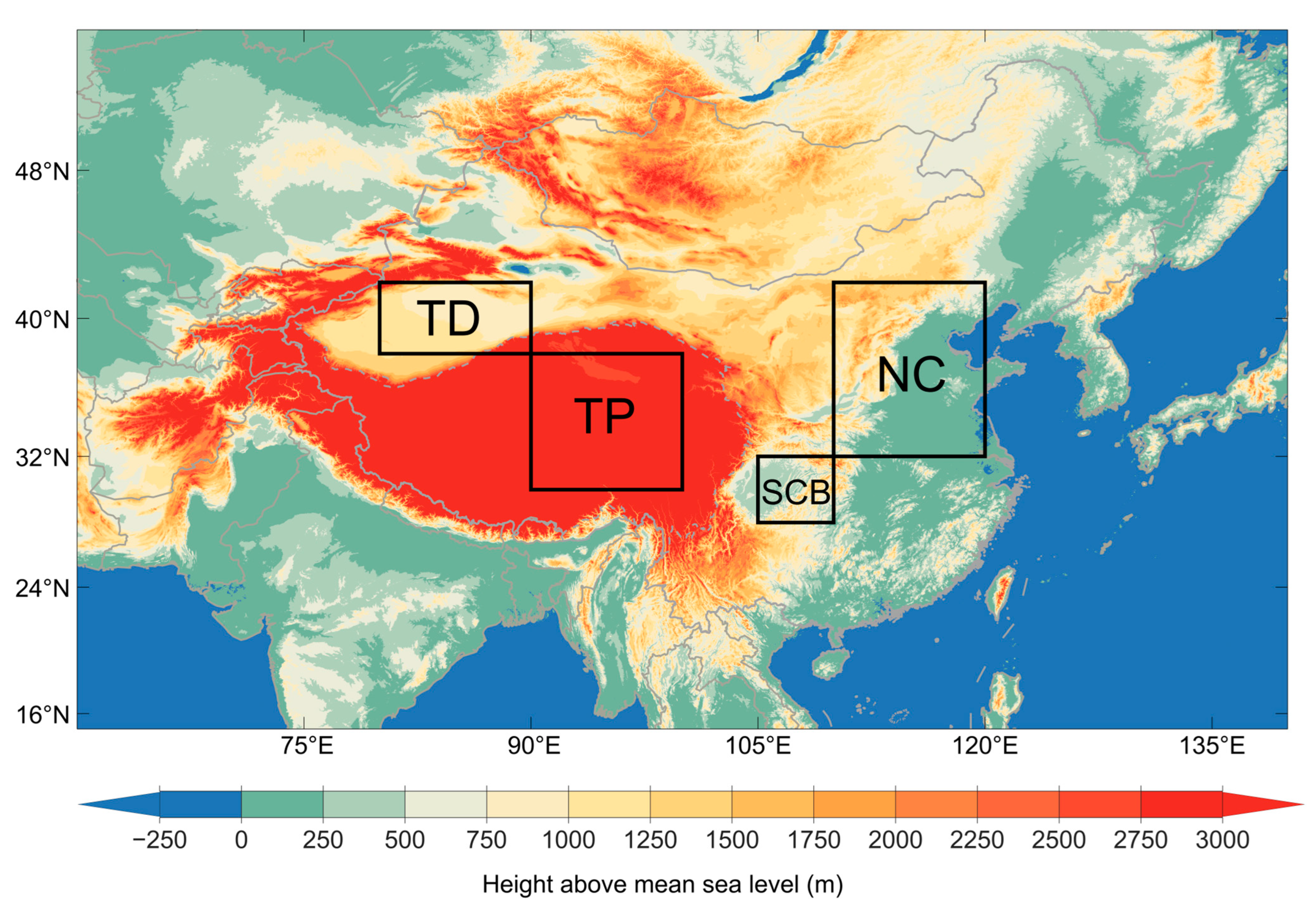


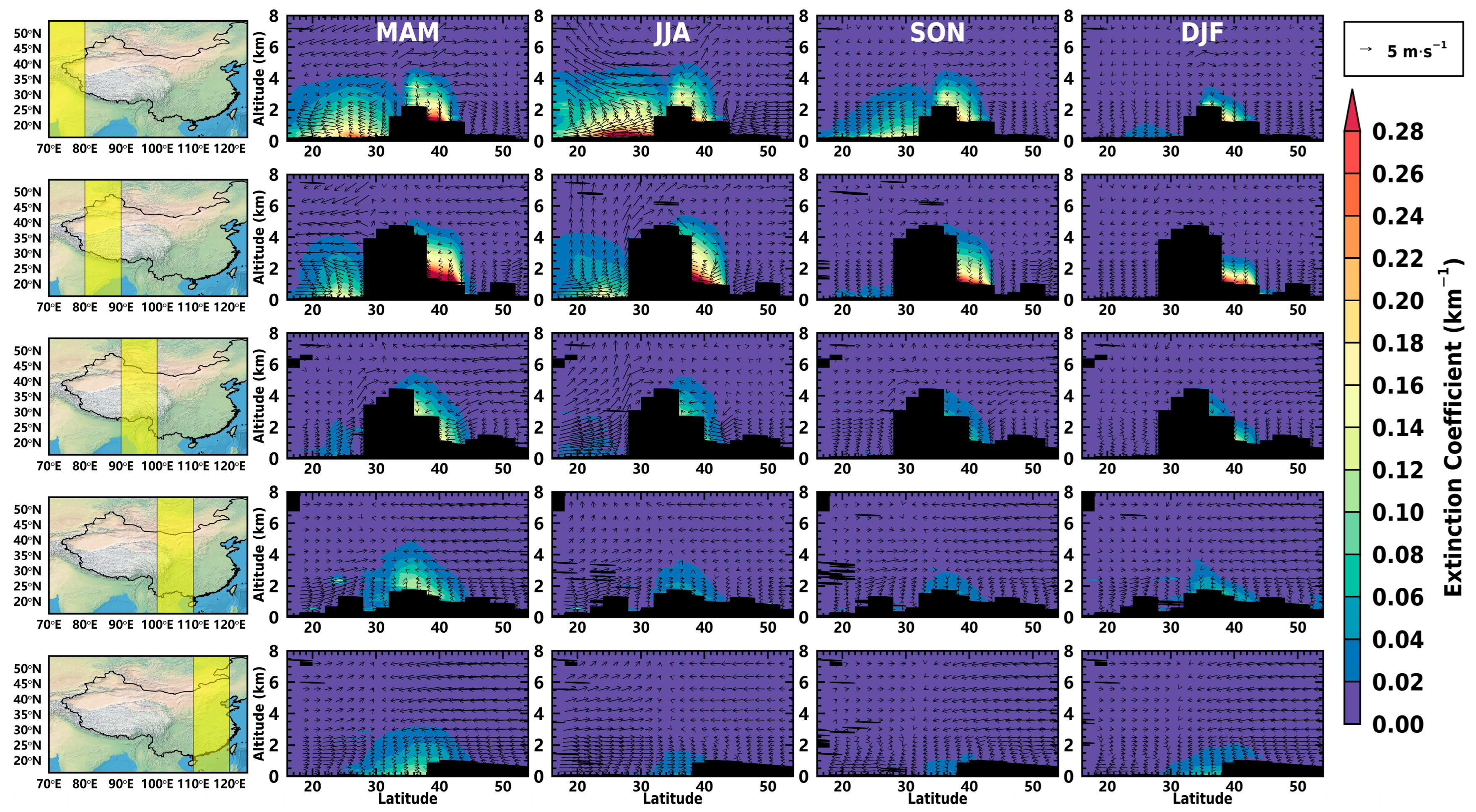
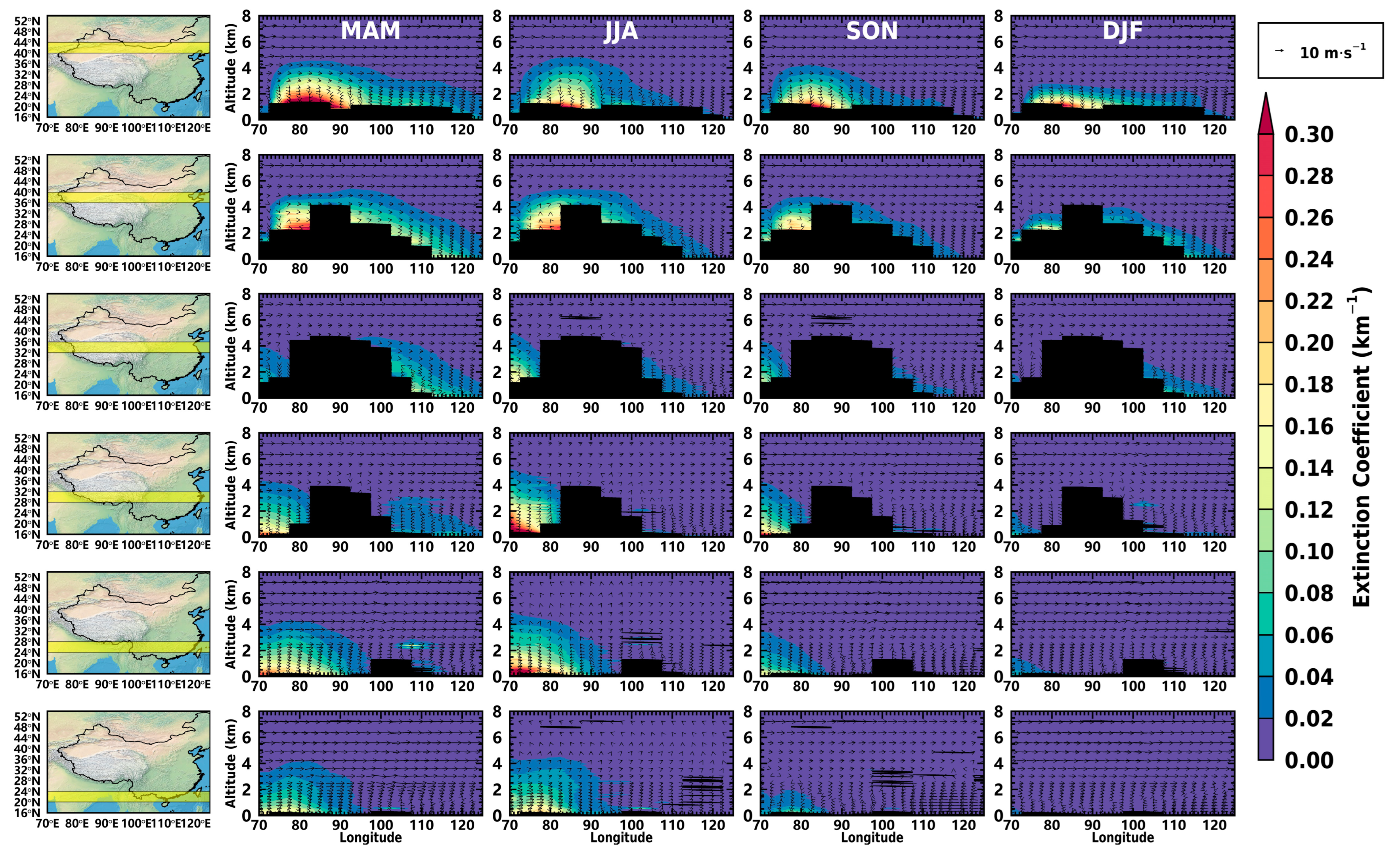

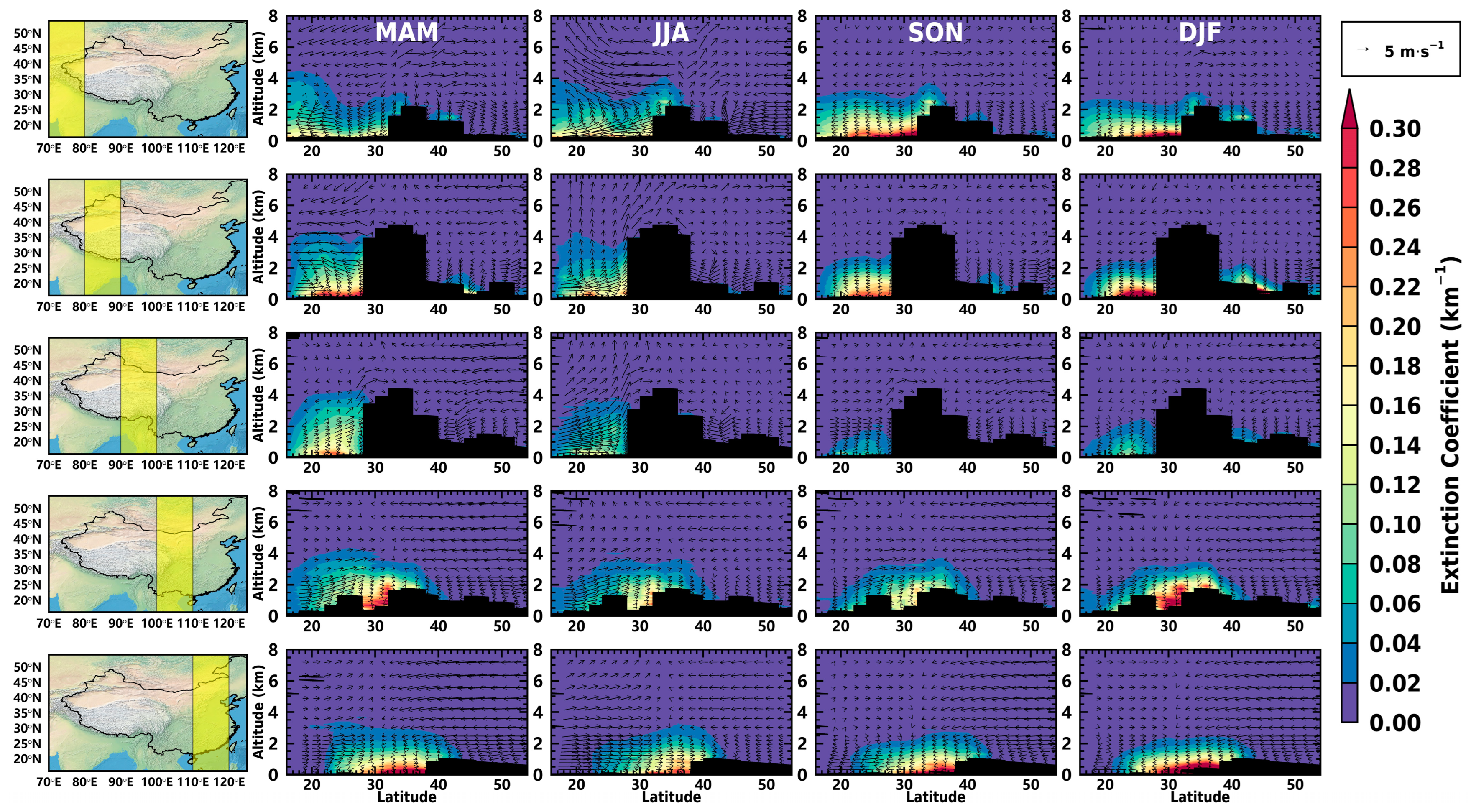
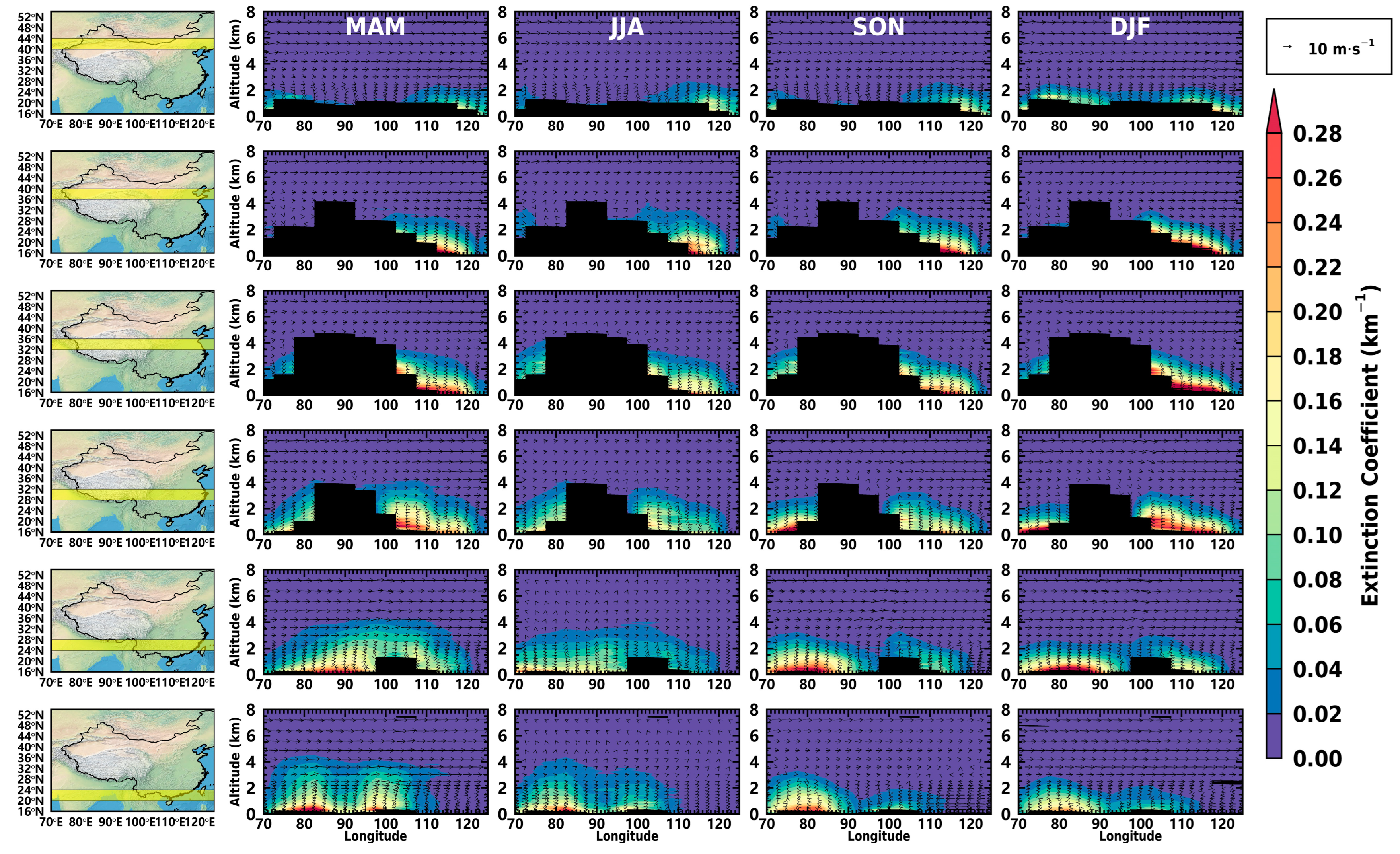


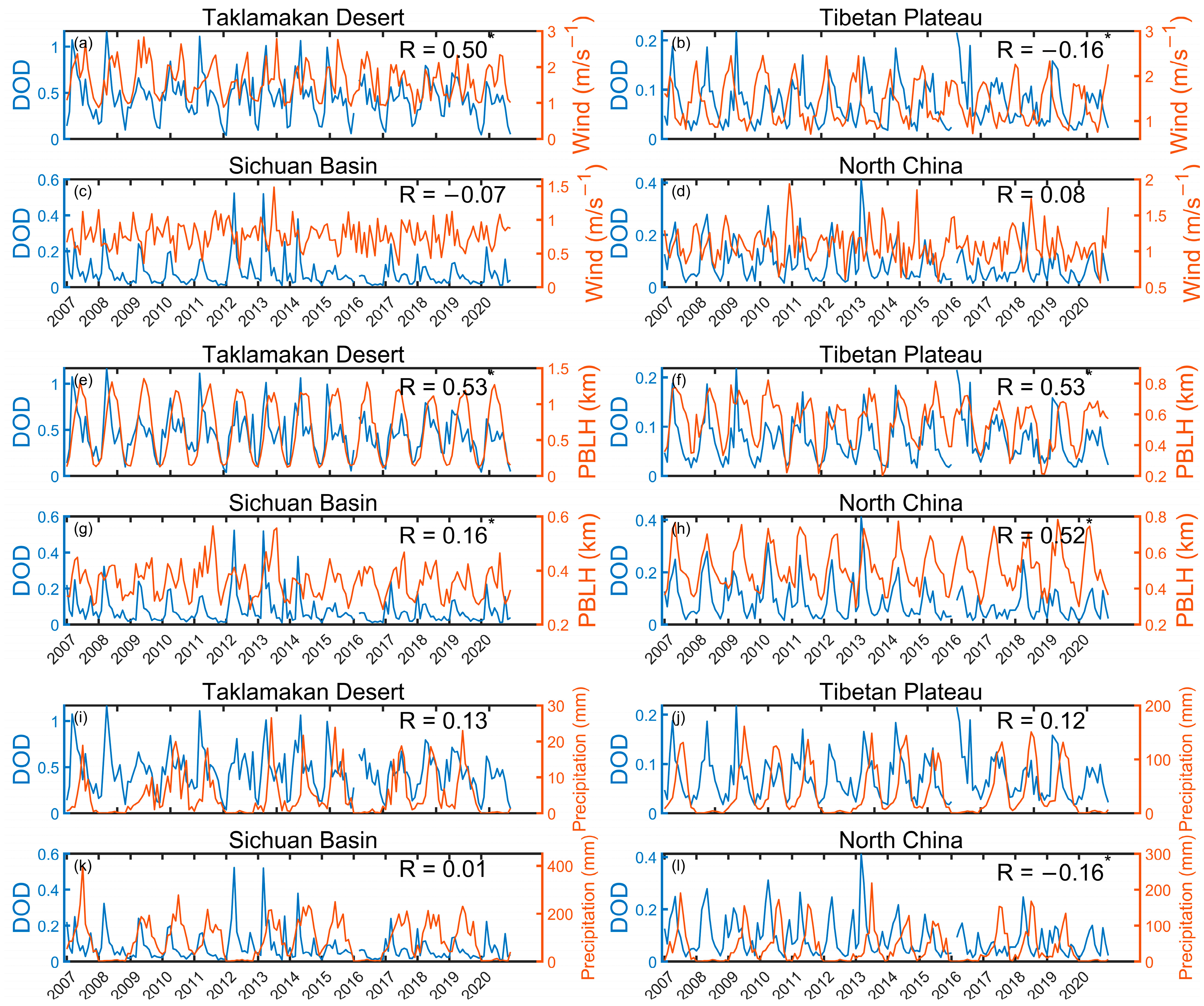

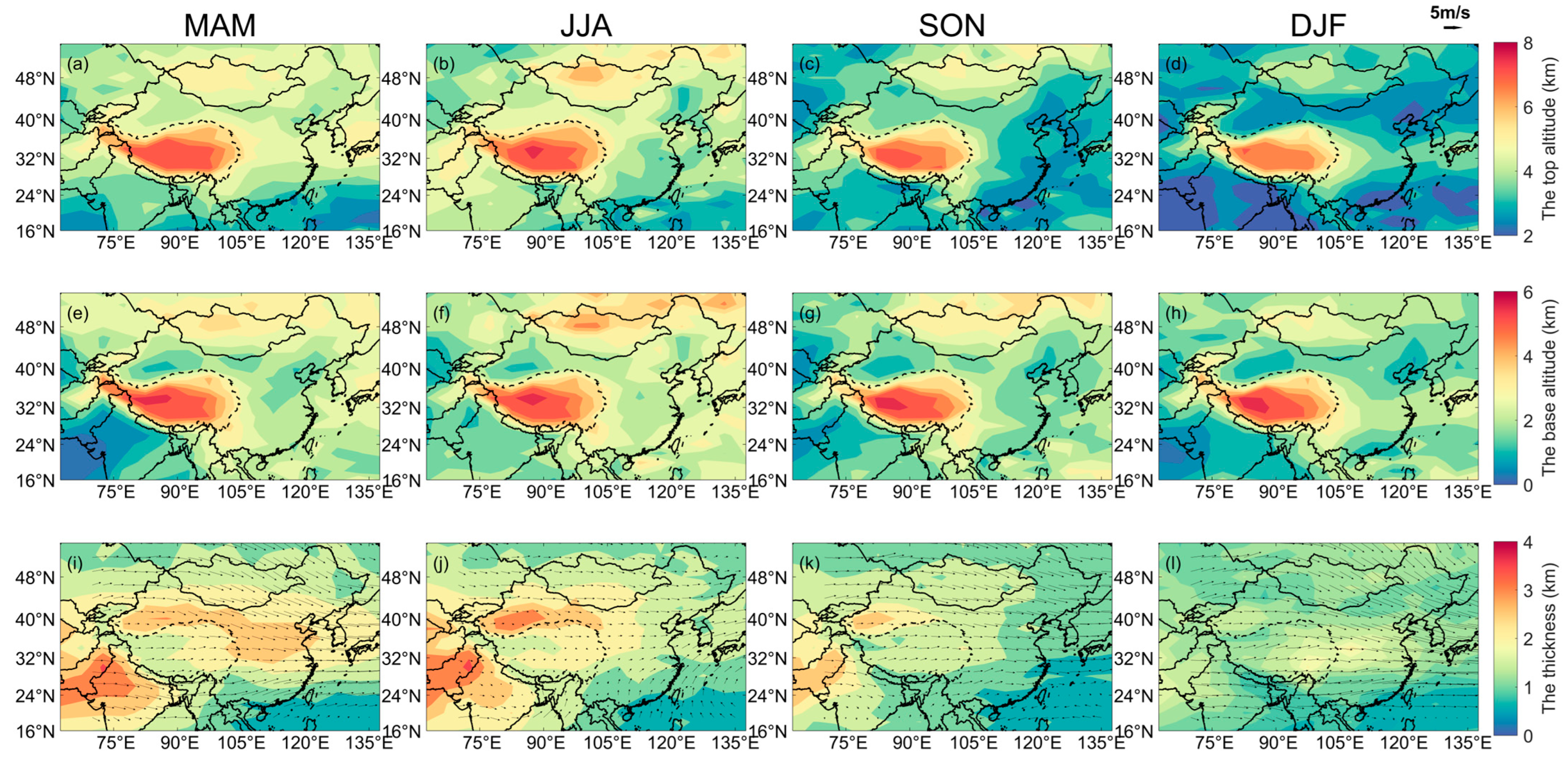
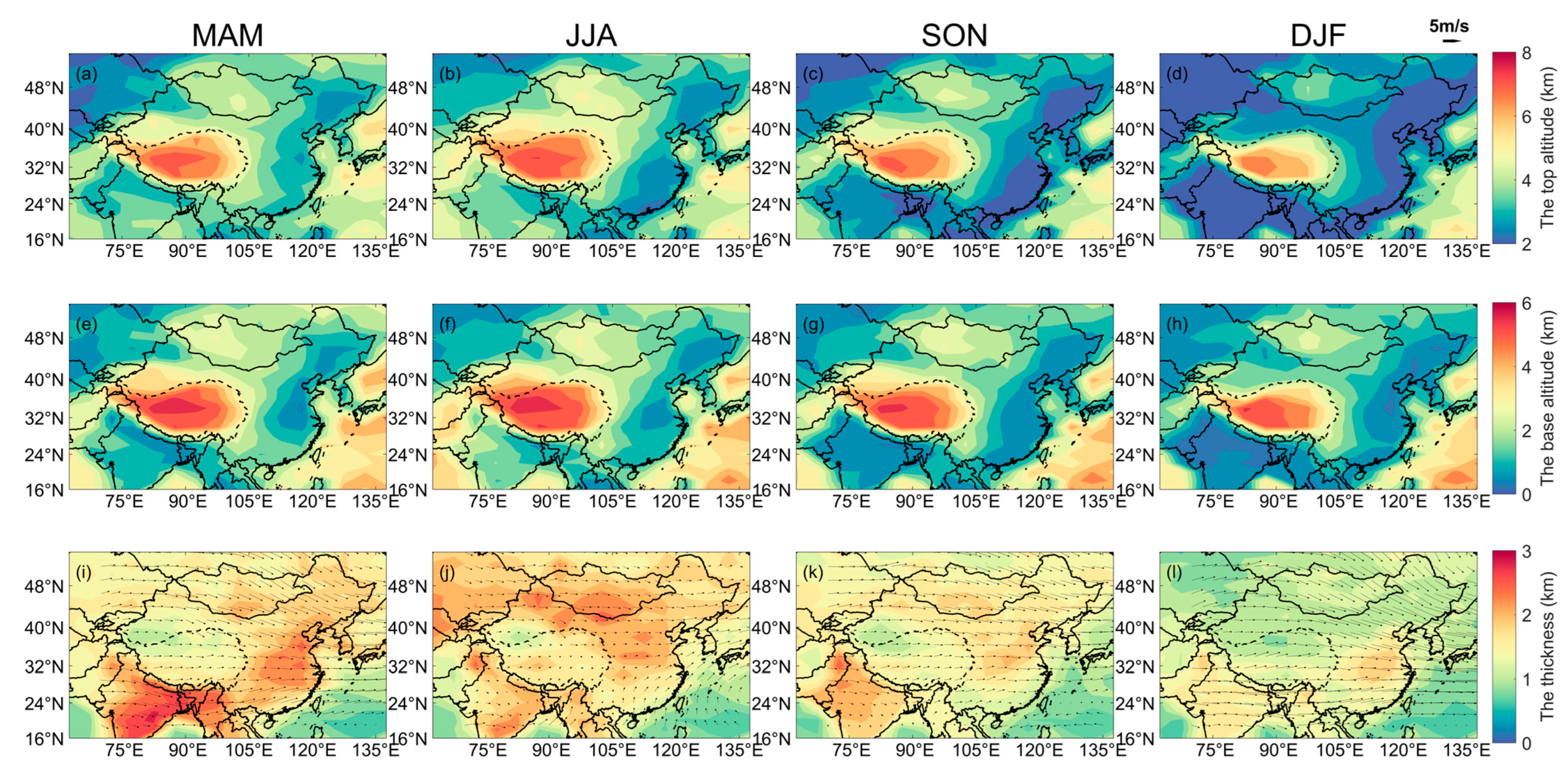


Disclaimer/Publisher’s Note: The statements, opinions and data contained in all publications are solely those of the individual author(s) and contributor(s) and not of MDPI and/or the editor(s). MDPI and/or the editor(s) disclaim responsibility for any injury to people or property resulting from any ideas, methods, instructions or products referred to in the content. |
© 2023 by the authors. Licensee MDPI, Basel, Switzerland. This article is an open access article distributed under the terms and conditions of the Creative Commons Attribution (CC BY) license (https://creativecommons.org/licenses/by/4.0/).
Share and Cite
Xu, X.; Yang, Y.; Xiong, Z.; Gong, J.; Luo, T. Three-Dimensional Distribution and Transport Features of Dust and Polluted Dust over China and Surrounding Areas from CALIPSO. Remote Sens. 2023, 15, 5734. https://doi.org/10.3390/rs15245734
Xu X, Yang Y, Xiong Z, Gong J, Luo T. Three-Dimensional Distribution and Transport Features of Dust and Polluted Dust over China and Surrounding Areas from CALIPSO. Remote Sensing. 2023; 15(24):5734. https://doi.org/10.3390/rs15245734
Chicago/Turabian StyleXu, Xiaofeng, Yudi Yang, Zixu Xiong, Jianming Gong, and Tianyang Luo. 2023. "Three-Dimensional Distribution and Transport Features of Dust and Polluted Dust over China and Surrounding Areas from CALIPSO" Remote Sensing 15, no. 24: 5734. https://doi.org/10.3390/rs15245734




